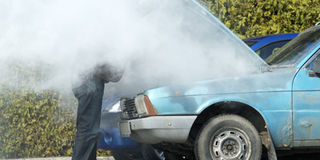When your car overheats

An overheat car gets on lock down and has the capacity to cause worse damages to other parts of the car. Courtesy Photo.
What you need to know:
- Flush the cooling system.
- Change the battery.
- Change your engine oil.
Herbert Olweny owns a 1995 Toyota Raum model registered under the UAR number plate series.
But he uses public means from Bweyogerere, east of Kampala to get to his work in the Kampala Central Business District because his car overheats every time he drives a distance of more than five kilometres.
This is a troubling reality for many motorists, especially those driving old cars.
The car, according to Olweny, heats up and automatically switches off in the middle of the road, which obviously inconveniences other road users.
“At first I thought it had run out of water. I topped up the water levels. It started again but after a few days it was doing the same thing,” he says.
According to Olweny, the car’s cooling system, his mechanic says, needs to be flushed as well as repairing other parts of the engine, which have been damaged in the process.
The repairs, he says, will approximately need not less than Shs500,000. But what causes a car to unnecessarily overheat?
Low oil levels
According to Abubaker Kimera, a mechanic at CKK Motor Garage in Wandegeya, the commonest cause of overheating in cars is low oil levels that some drivers ignore to check out.
This mostly happens, especially when the car is able to move from one destination to another until when it cannot hold any more.
“Engine oil does not just keep engine parts smooth and running but also prevents unwanted heat that the engine produces when it is running,” says Kimera.
Blocked or leaking cooling system
Beyond low oil levels, Kimera observes that the cooling system might be experiencing a blockage or leakage, thus causing unbalanced flow of water and other lubricants.
“If the coolant in your car is leaking or has been blocked by anything, it might not be able to reach every part of the cooling system to allow it run well. You may have to consider having your cooling system flushed at a service bay or garage to have it run normally,” Kimera advises.
Failing radiator fan
The fan helps to cool down the heated radiator and once it fails to adjust according to recommended pace the car will start to overheat immediately.
However, this and other car heating causes, can be prevented through a number of measures such as:
Flush the cooling system
In mechanical terms, Olweny’s cooling system needs to be flushed to facilitate a proper circulation of water as well as get rid of possible particles that may have blocked the system.
This process, Kimera says, is done a number of times in a single roll to help wipe out any particle that might have stuck in the system.
It is recommended that the car’s cooling system is checked at every service schedule.
Change the battery
As car batteries age they tend to work a little more than when they are new. This results into overheating of some parts.
Therefore, according to Edgar Kaweesa, a mechanic at Old Kampala, always ensure that you change your car battery every after three or five years, considering manufacturer advice and configuration.
“Your battery reaches a point when it has to work extremely hard to run the car, which might result into overheating,” Kaweesa says.
Change your engine oil
Oil, according to Kaweesa, does not only keep engine parts well lubricated but prevents them from overheating which might be a result of friction.
Therefore, he says, ensure that you change engine oil as and when it is due.
Eighty per cent of cars that develop overheating problems are found to have defects that connect to oil deficiencies.
Always check out your temperature gauge
Many drivers never bother to understand the status or reading on a car’s temperature gauge until when the car gets a problem.
According to Kaweesa, a well serviced car has a functioning temperature gauge whose reading must always be below the green mark (in some cars it is a blue mark)
“When your temperature gauge crosses into the red line, it is an indication that your car is overheating due to a broken down thermostat,” he says.
Once the thermostat is blown out, Kaweesa says, it must be replaced and the cause of the overheating must be investigated.
The thermostat regulates the flow of engine coolant to the radiator and maintains the required levels of temperature.




